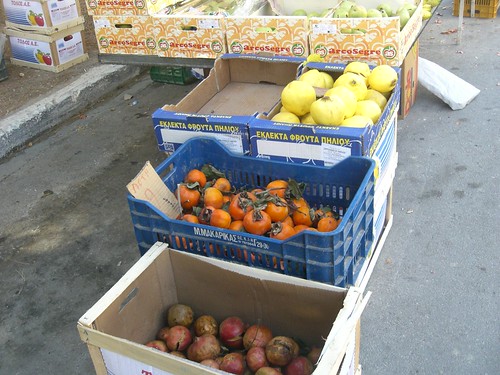
These autumn fruits are all being sold at the street market now: yellow quince, orange persimmon and crimson-yellow pomegranate.
The good...
Pomegranate is one of my favorite autumn fruits. I was given these ones by an aunt. Its sweet, tasty flavour, in combination with the stunning colour of the fruit, make this comestible a beauty queen. Pomegranate has a lovely round shape, with a characteristic star-like cone at the tip. On opening the fruit, you will be surprised to find that it contains juicy red seeds. This is what is eaten from the pomegranate; the seeds are scooped out with a spoon, while the skin is discarded - it's as tough as leather. It makes a beautiful addition to a winter fruit basket. It has a beautiful name in Greek: ρόδι - rodi (in Crete, we also call it rogdi) - a derivative of the word 'ρόδο', meaning 'rose', referring to its shape, the colour of the fruit, its smell, or all of these.
One of my favorite stories from ancient Greek mythology involves the pomegranate. Despite their positive attributes, pomegranates carry negative connotations in ancient Greek culture. Persephone, daughter of the goddess of fertility and agriculture, Demeter, ate some pomegranate while she was living with Hades in the underworld, which is how the seasons are explained in Greek mythology: she ate six (no one really knows if she ate six seeds or six pomegranates), which is why we have six cold months and six warm months every year. During the spring and summer, Persephone is living above ground with her mother Demeter, while in the autumn and winter, she's underground keeping Hades company. Demeter is overcome with grief, expressing her loss in the bare trees and cold weather. Since pomegranates are so closely associated with the underworld, it is no surprise that these seeds are added to the boiled wheat cakes (the koliva) that are served after a memorial service held at the Greek Orthodox church for a loved one who has passed away.
The pomegranate has quite a different popular history in Armenia, where it grows in abundance; it is a symbol of joy, representing fertility, abundance and marriage. My Armenian students at the institute where I work tell me that its seeds are added to salads, pressed into a juice, added to a meat marinade, apart from being eaten fresh; pomegranates are eve turned into a wine. One of my favorite Armenian students was named Anahit. When I saw a box of imported pomegranates at the market bearing the name ANAHITA, I asked her about the history of her name and its relationship with pomegranates. She told me that Anahita was the Persian goddess of fertility, and is symbolised as holding a pomegranate in her hand; Armenia and the ancient culture of Persia have intertwined histories.
... the bad...


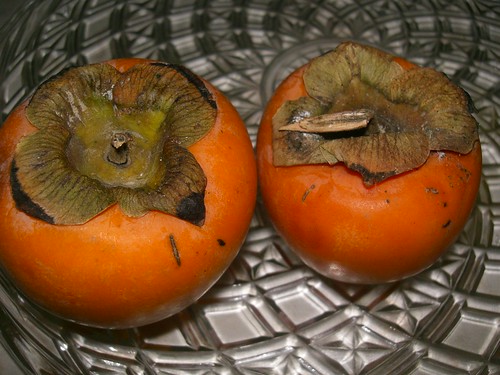
With the appearance of an unripe tomato (both inside and outside), the exotic persimmon, λωτός (lotos as it is called in Greek), is considered a berry (a berry berry large one). If you see them growing on a tree, you'll think they look like luscious apples ready for picking. A bite off one of these, and you'll be searching for a bathroom to wash out their acrid taste. Then you'll start worrying that your tongue has grown furry; really revolting. They really are an acquired taste, something these fruits often seem to lack.
These were given to me by my uncles who gave me some advice about when to eat them. You have to wait until the fruit looks like a soft tomato. If it isn't wholly ripe, red, soft and juicy, it will taste very bitter; it needs to look as though it is rotten. The fruit is often picked before it is mature enough to eat, and ripens on its own over time. When ripe, it is pulpy rather than fleshy.
Its name in Greek sounds like 'lotus', the common name for another exotic fruit, but one that is totally unrelated to the persimmon. So what did the lotus eaters eat when they ate lotus - persimmon, or lotus fruit? Only Odysseus knows the answer to that one. Apparently, this fruit was so delicious, that Odysseus' crew didn't want to leave the island where they found it, and Odysseus nearly never made it back to his beloved Ithaca.
I've come across a lot of persimmon recipes over the internet, the pulp of the fruit being added to soft cookies, cakes, pies and bread. I was touched when I saw a persimmon walnut cake, made by my sinonomati Maria from New York, using persimmons from her uncle's garden who lives in one of the oldest Greek neighbourhoods of New York, Astoria.
Its name in Greek sounds like 'lotus', the common name for another exotic fruit, but one that is totally unrelated to the persimmon. So what did the lotus eaters eat when they ate lotus - persimmon, or lotus fruit? Only Odysseus knows the answer to that one. Apparently, this fruit was so delicious, that Odysseus' crew didn't want to leave the island where they found it, and Odysseus nearly never made it back to his beloved Ithaca.
I've come across a lot of persimmon recipes over the internet, the pulp of the fruit being added to soft cookies, cakes, pies and bread. I was touched when I saw a persimmon walnut cake, made by my sinonomati Maria from New York, using persimmons from her uncle's garden who lives in one of the oldest Greek neighbourhoods of New York, Astoria.
... and the ugly.
Quince is a weird fruit. It's too tough to eat raw, but when cooked, it can be turned into either a sweet, or as a substitute for potato or root vegetables in a roast. My mother often made quince spoon sweet in New Zealand, which she bought at the Tory St Market in Wellington. Believe it or not, despite its ancient links, quince was growing in New Zealand well before New Zealand was colonised, and the Maori were using it as a food item. During my time in New Zealand, quince was already starting to sound like an old-fashioned fruit, although it is making a big comeback in cuisines all over the world, given the increased attention paid to natural food sources. Quinces looks like a badly formed apple - or maybe an overgrown pear. In its raw form, it has a hard woody taste. It undergoes an incredible transformation once it is cooked.
Quince is called κυδώνι 'kydoni' in Greek. Kydonia was also the name given to Hania in ancient times, a name that still survives in the town, especially in the form of Kydon, the name of a hotel, a TV channel, a sports club, and a whole host of small businesses in the summer resort town of Hania. Quinces were grown in Crete, from where they spread to other areas of ancient Greece, taking the name with them for this unusual fruit. The 'apple' that Paris gave to the ancient Greek goddess of love, Aphrodite, might actually have been a quince; in any case, it was enough to start the Trojan war...
The quinces in the photo were being sold at the market; they are not as ugly as the ones I have seen growing on trees in the village. Their shape is usually asymmetrical, they have rough patches on their skin, and they also seem to have a dusty grey fur covering their skin. So why did I call it an ugly fruit? It's a bit like the ugly duckling. This yellow-on-the-outside, creamy-white-on-the-inside fruit turns a muddy brown as soon it is sliced through, like an apple. As it starts to cook, it seems to become bleached white, turning different shades the longer it cooks, uintil it becomes Cinderella pink. When sliced through - if your quince is slightly unripe, you'll need a good knife and a lot of patience to peel them - it exudes a sweet aroma; quinces have even been known to be used as air fresheners!
(I made this quince sweet using Nancy's recipe, which resembles my mother's method to cook quince; Nancy also details another recipe for grated quince. They are very similar to each other, and equally delicious.)
There is still a place for spoon desserts in our times. They are often served at the end of the meal in tavernas, sprinkled over strained Greek yoghurt. This makes a fantastic end-of-dinner dessert, much lighter than ice-cream, since spoon desserts contain no fat, and the yoghurt is usually not sweetened. Quince spoon sweet is also a perfect dessert for Christmas, with its pinky-red hues. Serve it with a spoon sweet fig, and you're looking at Christmas on a plate. And if you do want to make it in time for Christmas (which, my children keep telling me, is only a month away), you'll have something ready to serve on the day with trifle, ice-cream, pudding or yoghurt.
This is my entry for this week's Weekend herb Blogging, hosted this week by Scott from The Real Epicurean.
©All Rights Reserved/Organically cooked. No part of this blog may be reproduced and/or copied by any means without prior consent from Maria Verivaki.
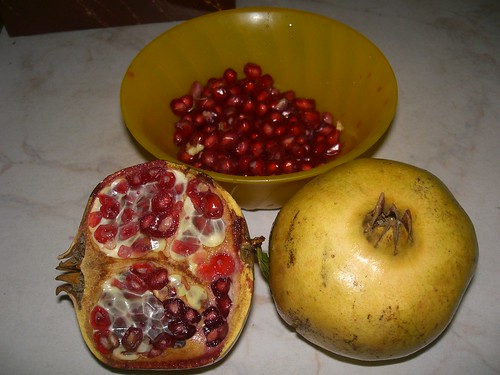
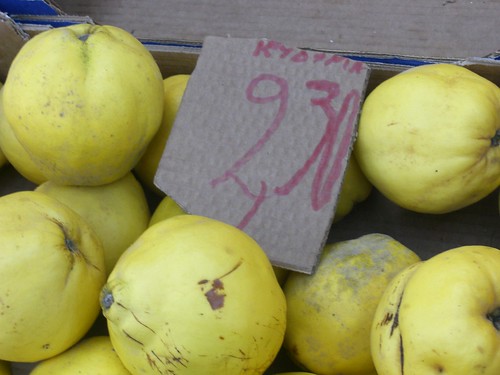
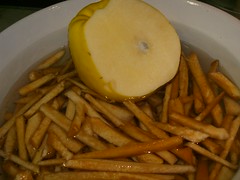
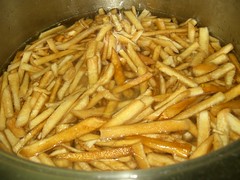


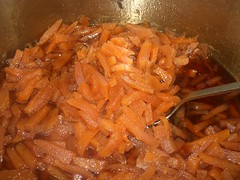

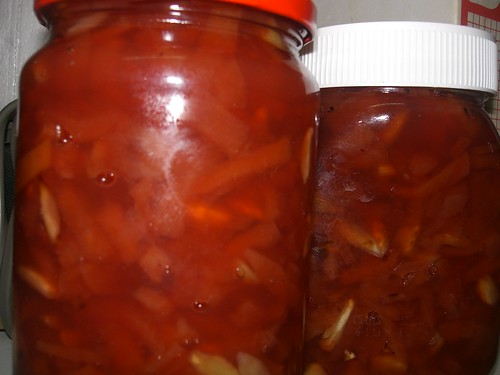
You know, Maria, I don't read blogs. For the same reason that I don't know who Jennifer Aniston last kissed, I stay away from them -- I'm just not interested in the details of strangers' lives.
ReplyDeleteBut yours is a story book which transports me into my giagia's kitchen, my rented flat in Greece, the xwrio, my mother's memories of eating quince and pomegranates as a girl in Greece and any else either I or my imagination may have wandered.
Thank you for writing!
(In case you're wondering, I stumbled on your blog looking for, what else, a recipe... To tell you the truth, I refused to bookmark it for weeks because I couldn't face that I was reading a blog... luckily I soon realized I wasn't!)
A fall recipe you might enjoy (not very Greek... oh my!): Pomegranate, crushed pistachios, roasted chestnuts mixed with couscous, olive oil, some sort of citrus (say, the zest and juice of a lemon and/or orange) and the following spices (all improvised and improvise-able, of course): saffron, coriander, cardamom and clove (I grind and toast them, but I don't know how important, if at all, that was...). Getting your family to eat such a strange concoction might certainly be difficult, if not impossible, but I tried this the other day, enjoyed it and thought I'd throw it your way.
hi christina, you are just the kind of person i want reading this blog. i have always tried to avoid diary writing, and i want my writing to be timeless, so you've made my day today!
ReplyDeleteI LOOOOVE quince spoon sweet . i love it.
ReplyDeleteMy three favorite fruits for sweet and savory dishes. ΜΜ!! Ωραίο το γλυκό σου Μαρία!
ReplyDeletePetros and I made quince jam this year. We have two quince trees with lots of fruit and he didnt want it to go to waste, as it usually does
ReplyDeleteHow about Musmula. I think these are called Medlar's in the UK (and are not something you can actually buy unless you seek it out specially). The french call them "cul de chien" or 'dogs arsehole' - and for good reason (google an image of one - very very ugly).
ReplyDeletehi aris - mousmoula (or despoles, as we also call them here in hania) are a delicious spring fruit (they're not available now). we have two trees in the village, but they are drying up and we need to replant them.
ReplyDeletethat coffee story is coming alon, by the way...
If Mousmoula are spring fruits, then they are probably not the same as medlars which are one of the latest ripening fruits (mid November).
ReplyDeletei just looked them up and i;d say the tree looks the same, but the fruit doesn't. the greek mousmoula/despoles are the locquat fruit.
ReplyDeleteΕυρηματικός τίτλος. Μ' αρέσει!
ReplyDeleteHow wonderful. I think over here the most common way quince is used is to make jelly. I've never had persimmon, but have tried pomegranate (I wasn't mad on it, but I like the idea of the seeds in a salad). I just love the different explanations of the pomegranate imagery in Greece and Armenia! Great writing again Maria :)
ReplyDeleteI don't care what anyone say - these are the types of fruits I like! Yum!
ReplyDelete-DTW
www.everydaycookin.blogspot.com
Lovely blog. You're lucky to have access to a variety of organic produce.
ReplyDeleteI look forward to the fall just for my two favorite fruits of the sesason; persimmons and pomegranates. We visited a persimmon farm recently and we picked so many persimmons. It's delicious. I have a post coming up about them. It's great that you took the time and blogged about these fruits. Very informative. Thanks!
I have never seen a persimmon tree:D
ReplyDeleteI learn so much from your blog! That's why I come back again and again. You see, we do not grow persimmon, nor quince nor pomegranates here in this tropical country. I have seen them though, in the imported sections of stores, and these are quite expensive! Your post inspire me to try and taste these fruits soon! :)
ReplyDeleteMy parents tell me/remind me/taunt me with their memories of persimmons in Greece and I so want to try one!
ReplyDeleteThe ones here are good but the Greek ones have to be better.
My Mum used to buy a pomegranate and give my sister and I a toothpick to pick the seeds out. we loved it but it only now I realise it was a great way to keep us quiet too!
ReplyDeleteQuince jelly is marvellous with a nice cheese.
Yum.
Hi Maria, Wanted to respond to your question about substitutes for shortening. You're correct that the shortening (also sometimes called by it's name brand Crisco)is very white. It's similar in texture to softened butter, but it can't be used interchangeably with it. For the candy recipe, if you don't have shortening, I'd not worry about it. I wouldn't use butter instead because it might make the chocolate "seize up". Instead, just melt the chocolate and dip the little balls directly into it. I think they would turn out just fine that way. Hope all is well ... I'm behind in my blog reading ... my littlest one is still very sick and I spend a lot of time just holding her. Will catch up soon ....
ReplyDeleteFascinating reading, loved the mythology explanation, just fantastic.
ReplyDeleteWe literally hit raw quince to make it soft and juicy to eat. It worked when I was little!
Quince and persimmon are very rare here.The divine Pomegranates are my new favorite.
ReplyDeleteoh i just feel like im in a market hunting for great fruits to try in my kitchen :-) we are lucky quince and persimmon are not at all rare here in southern france, specially quince you can always find them in the forest. my mom in law makes the best candy bars out of them :-)
ReplyDeleteI adore persimmon season, one of the many fruits I've fallen in love with living in Australia. We seemed to have so few varieties of fruit in NZ growing up (though I do miss tamarillos/"tree tomatoes" and feijoas that are rare and expensive treats here). The only thing I do with them is eat them raw. How wonderful and heavenly.
ReplyDeleteI was given quinces last year and made quince paste http://confessionsofafoodnazi.blogspot.com/2007/03/another-one-for-owl-and-pussycat.html - what a labour of love!
If you have lots of pomegranates you could try making pomegranate molasses - that lovely middle eastern syrup. I think the juice is just cooked long and slowly til its reduced to a thick syrup, then bottled.
Enjoy your cornucopia :)
Yes,Persimmon or Sharon fruit..you have to eat it when the skin turns kind of translucent and about to break or your cheeks will suck inwards! Loved reading about ipovrixio and spoon sweets. I have to wait for my familys yearly trip to Greece to get some and they disappear in no time!
ReplyDeletePersimmons yes, the ones in the picture are called fuyu and are edible just as an apple, peeled or not, crispy or soft.They do not need to "sit", I like them better a little crunchy and peeled, quite addictive. The ones you describe are the hachiya persimmons they need to ripen fully till extremely soft ,can be eaten with a spoon, then they are a delight, they are also excellent dried.
ReplyDeletePersimmons yes, sorry I made an error in my previous post, the picture of the tree shows Hachiya , the ones eaten soft, Was mistaken by the angle of the picture of the two persimmons.
ReplyDeleteNow how about figs!!, I love figs and grow a few.
This comment has been removed by a blog administrator.
ReplyDelete